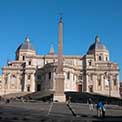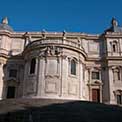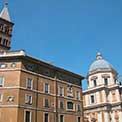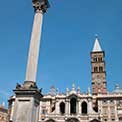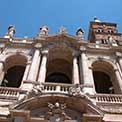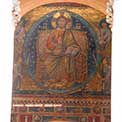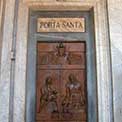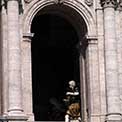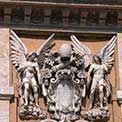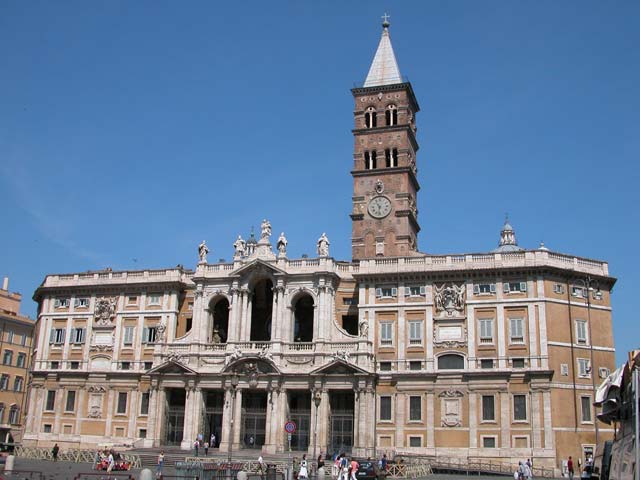
In front of the square of St. Mary Maggiore, is a kind of column of Egyptian granite, on which are figures of the Madonna and the Crucifix. This is a monument erected by Clement VIII, in 1595, in memory of the absolution given to Henry IV. of France.
Next follows the square of St. Mary Maggiore; in the middle is placed, on a large pedestal, a magnificent fluted Corinthian pillar of white marble; the only entire one remaining, as we before said, from the celebrated Temple of Peace. It is 58| feet high, including the base and chapiter, and 19 feet 3 inches in circumference. Paul V. erected it here under the direction of Carlo Maderno, and placed a gilt bronze statue of the Madonna at the top; modelled by William Bertolot. In this square is the
Cathedral of St. Mary the Great
BASILICA DI S. MARIA MAGGIORE
This church, which is built on the summit of Mount Esquiline, and on the ruins of the Temple of Juno Lucina, was erected in 352, under Pope St. Liberius, by order of John Patrizi, a Roman, in consequence of a vision which both had in one night, and which was confirmed by a miraculous fall of snow the following day, the 5th of August. This snow precisely covered the space which the church was to occupy; it was therefore called Sta. Maria ad Nives, and Basilica Liberiana; but it is now named S. Maria Maggiore, being the principal church dedicated to the Virgin. It is one of the seven Roman cathedrals, and one of the four which have the holy doors. Pope St. Sixtus III. enlarged it in 432, and gave it its present form. It has since been repaired and enriched by several Popes, particularly by Benedict XIV., who adorned it with marbles and gilt stuccos, and rebuilt the principal front from the designs of Ferdinand Fuga; it is decorated with two rows of columns, Ionic and Corinthian, various statues, and a double portico; the under one is sustained by eight fine granite columns, and different marble pillars. This portico is adorned with basso relievos, and a bronze statue, by Cavalier Lucenti, of Philip IV. of Spain, benefactor to this cathedral. In the upper portico is the balcony used for the Papal benediction; under which are preserved the mosaics that adorned the old front, works of Gaddo Gaddi, contemporary with Cimabue. There are four entrance doors, without reckoning the holy one, which is only opened the year of the great jubilee, namely, every twenty-five years.
The interior of this church is majestic; it has three naves, separated by thirty-six fine Ionic columns of white marble; besides the four granite ones, which sustain the two large arches of the nave. On entering, may be seen, two tombs, one of Clement IX., sculptured by Guidi, Fancelli, and Hercules Ferrata; the other of Nicholas IV., by Leonardo da Sarzana.
The magnificent chapel of the Holy Sacrament, erected by Sixtus V., from the designs of Cavalier Fontana, is adorned with fine marbles, Corinthian pillars, and paintings. On entering, to the right, seen the tomb of this Pope, whose statue was sculptured by John Antonio Valsoldo; this tomb is adorned with four fine columns of antique green marble, basso relievos, and two statues, one of S. Francis, by Flaminio Vacca; the other of St. Anthony of Padua, by Peter Paul Olivieri. Opposite is the tomb of St. Pius V., whose body is preserved in a fine urn of antique green marble, ornamented with gilt bronze; there are also some columns, basso relievos and statues; that of this holy Pontiff, is by Leonardo da Sarzana. In the middle of this chapel is the Altar of the Holy Sacrament, with a magnificent Tabernacle, supported by four gilt bronze angels. The frescos in this chapel are by John Baptist Pozzo, Hercolino Bolognese, Arrigo, Paris Nogara, Andrew d'Ancona, .and Cesar Nebbia: in the sacristy are some landscapes, by Paul Brilli.
The great altar of the cathedral is isolated, and formed by a large porphyry urn, covered with a marble table, and sustained by four small angels of gilt bronze. Over this altar is a superb canopy, made from the designs of Fuga, by Benedict XIV.; it is supported by four porphyry Corinthian columns. Above are six marble angels, sculptured by Peter Bracci. The picture at the end of the gallery is by Francis Mancini; and the Mosaics, are by James da Turrata. The Mosaics over the great arcade, and those of the middle nave, representing different subjects from the Old Testament, and Events in the Life of the Virgin, were made in 434, by St. Sixtus III.
In the other nave is the sumptuous Borghese Chapel, made by Paul V., of that family, from the designs of Flaminio Ponzio: it is the most magnificent in Rome. It is of the Corinthian order, filled with fine marbles and paintings. There are two tombs decorated with columns of antique green-marble, statues and basso relievos; the one to the right on entering, is of Paul V., whose statue was sculptured by Silla Milanese ; the right basso relievo is by Stephen Maderno; the other by Bonvicino. Of the three basso relievos above, the middle one is by Hippolito Buzi; the one to the right by Vasoldo; and the other by Francis Start. In the side niches are the statues of St. Basil and David, by Nicholas Cordieri. The other tomb is of Clement VIII., his statue is by Silla; the basso relievos are by Bonvicino, Buzi, Mochi, and Peter Bernini. The two statues in the side niches of Aaron and St. Bernard, are by Henry Cordieri, Lorenese (of Lorrain).
The magnificent altar of the Virgin, is decorated with four splendid fluted columns of oriental jasper, which support an entablature ; the frieze is of agate, as well as the pedestals of the columns. The image of the Virgin, said to be painted by St. Luke, is placed on lapis-lazuli; it is surrounded by precious stones, and sustained by four bronze angels. On the entablature of this altar is a fine basso relievo of gilt bronze, representing the miracle of the snow.
The paintings over and around the altar, and those of the arcade and angles of the cupola, arc by the Cavalier Arpino; those in the cupola are by Louis Civoli. The paintings by the sides of the windows over the tombs, are worthy of notice, as likewise those of the two arches over the windows, which are by Guido Reni.
A new Picture of Rome, and its Environs, in the form of an Itinerary - Mariano Vasi - 1819

